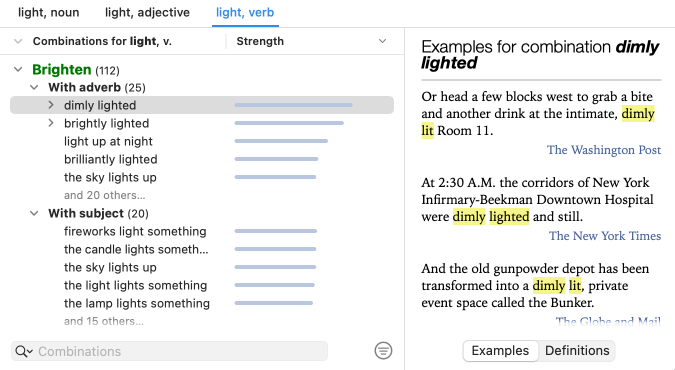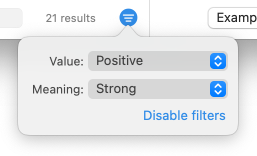Content of the Dictionary of Combinations
The dictionary of combinations gives all the most significant lexical combinations of the headword, grouped by syntactic context, the strength of the combination and, if applicable, the various meanings of the headword.
-
 CBDA1234
CBDA1234
Significant lexical combinations are made up of two or more words (the base and the co-occurrent words) with a strong, frequent and spontaneous association in the language. How, for instance, can one describe a bright light? It may be a flashing light, blinding light, clear light, brilliant light, and so on. The dictionary of combinations gives you an exhaustive list of the statistically strongest associations, in all the relevant syntactic contexts.
List of combinations
The headword’s combinations are displayed in a vertical list. In some cases, longer sub-combinations, such as set of traffic lights in the above figure, are grouped under a combination they contain, in this case traffic lights. You can select a specific combination and then use the button in the tool bar to insert it into your text. When a particular determiner or preposition is part of a combination (wait at traffic lights, bathe in blue light), it means that that function word is significantly frequent in that particular context. You can scroll through the combinations using the vertical keyboard arrows and show sub-combinations using the horizontal arrows.
Labels
If a combination belongs to an informal register, a usage label (e.g. INFORMAL, OFFENSIVE) appears to the right of the combination. If a usage label applies to all combinations for a given headword meaning, it is not repeated next to each combination; instead, it is shown to the left of the heading that indicates the meaning.
Strength of combinations
A blue bar opposite each combination shows its relative statistical strength: the longer the bar, the stronger the combination in comparison with the other combinations in the same context. The strength depends on a combination’s frequency, but also on the uniqueness of the association between the terms.
Meanings

When a word has several meanings, its combinations are grouped by meaning. The meanings are displayed in green, accompanied by a hide/show chevron.
Syntactic contexts
Combinations are grouped by syntactic context: with adjective, with noun adjunct, with possessive and so on; the number and nature of the contexts depend on the category of the headword. To allow an overall view of all the contexts, only the first five combinations for each context are displayed. You can see the others by clicking the grey text and x others, if applicable. You can expand or shrink each context using its hide/show chevron. The number of combinations for each context is shown in parentheses after the name of the context.
Sorting
Combinations are sorted according to their strength by default. You can also sort them in alphabetical order of the first word in each combination by clicking the title bar.
Hide/show chevron
The hide/show chevron lets you expand or collapse the lists of meanings or contexts at once, as applicable.
Examples and definitions
Selecting a combination displays, in the right-hand panel, examples of the combination in real texts (when the Examples button at the bottom of the panel is activated) or the definition (when the Definitions button is activated). The words in the combination are highlighted in each example text. Each example is accompanied by the name of the author and title of the source, if applicable, as well as a link to the source in blue. This hyperlink lets you open the source website in your browser with one click.
Web search link
At the bottom of the list of examples is the Web search link, which lets you search for the words in the combination in Google, should you want to search in more detail.
List of sources link
Clicking the List of sources link at the bottom of the list of examples displays all the sources used to compile the corpus from which the combinations and their examples were extracted.
Search filter

The search filter allows you to search for a string of characters in the list of combinations. Simply type the characters, making sure the Combinations option is selected in the magnifying glass () menu. When you are done, click the x on the right side of the search bar to bring back the complete list or begin a new search.
Cross with another word

Suppose you are writing a sentence that combines the verbs to study and to love (Clara studies and loves…), and you want to follow them with a direct object complement that combines well, without having an exact idea in mind. The cross-combinations feature will help you find the perfect complement. To do so, first look up the combinations for the verb to study (or the verb to love), then select the Cross with another word in the magnifying glass menu (). Enter love (or study) in the search bar and Antidote displays all the combinations that are common to both verbs, from which you simply have to choose the one you prefer: Clara studies and loves literature, film, animals, and so on.
- Cross-combinations give optimal results for two words in the same category (two verbs, two nouns, etc.).
Thematic filters

Click the button to filter the list of combinations based on their connotation (positive or negative) or meaning (strong or weak). These filters help you choose the combinations that are most likely to meet your criteria by shortening the list of options. To return to the original display, click the button again and then click Disable filters.